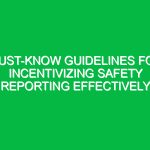“`html
Essential Tips for Effective Incident Report Writing: A Comprehensive Guide
Good morning team,
Today, we’re diving into a crucial aspect of our Workplace Safety culture: effective incident report writing. Understanding how to document incidents accurately not only helps in compliance with Safety Regulations but also plays a vital role in preventing future incidents. A well-crafted incident report can lead to improvements in our Safety practices and ensure that everyone goes home safe at the end of the day.
Understanding Incident Report Writing
Incident report writing refers to the process of documenting details about workplace incidents, including accidents, near misses, and safety violations. This documentation is essential for identifying patterns, addressing Hazards, and implementing corrective measures. Accurate and thorough incident reporting helps us recognize potential risks and fosters a culture of safety within our organization.
Many employees may think that incident reports are only necessary for serious accidents. However, even minor incidents can provide valuable insights into our safety practices. Remember, every report is an opportunity to learn and improve.
Key Hazards, Risks, and Safety Considerations
When it comes to incident report writing, several hazards and risks can arise:
- Inadequate Information: Failing to include all necessary details can lead to misinterpretations and ineffective corrective actions.
- Bias and Emotion: Personal feelings about an incident may cloud objectivity, affecting the report’s accuracy.
- Delay in Reporting: Waiting too long to document an incident can result in forgotten details, making the report less reliable.
Ignoring these hazards can have real-world consequences, such as repeat incidents, increased injuries, and potential legal ramifications for the company. It’s vital to treat every incident seriously and document it properly.
Best Practices, Procedures, & Actionable Advice
Here are essential steps and tips to enhance your incident report writing skills:
1. Be Prompt
Document the incident as soon as possible. This prevents loss of detail and ensures that your report reflects the facts accurately. Aim to write your report within 24 hours of the incident.
2. Use Clear and Concise Language
Avoid jargon and technical language that may confuse readers. Use straightforward language that anyone can understand. Your goal is to communicate the facts clearly.
3. Include All Relevant Details
Your report should contain:
- Date and time of the incident
- Location of the incident
- Names of those involved, including witnesses
- A detailed description of what happened
- Immediate actions taken
4. Focus on Facts, Not Opinions
Stick to the facts without adding personal opinions or assumptions. Describe what happened, not what you think might have happened. This helps maintain objectivity and credibility.
5. Review and Revise
Once you’ve completed your report, take the time to review and revise it. Check for clarity, accuracy, and completeness. If possible, have a colleague review it as well for an additional perspective.
6. Utilize Visual Aids
When applicable, include photographs, diagrams, or sketches that can support your written account. Visuals can help clarify the situation and provide context.
7. Learn from Past Reports
Review previous incident reports to identify patterns or recurring hazards. This analysis can guide you in preventing future incidents.
Case Study: A Real-World Incident
Consider the case of a worker who slipped on a wet floor. The incident report documented the time, location, and environmental conditions, but it failed to mention the lack of warning signs. As a result, the company implemented better signage protocols, which significantly reduced similar incidents in the future. This example illustrates how effective reporting can lead to actionable safety improvements.
Regulations, Standards, and Compliance
Many regulatory bodies, such as OSHA, mandate detailed incident reporting as part of safety compliance. Familiarize yourself with these requirements to ensure your reports meet legal Standards. Compliance not only protects employees but also safeguards the company from potential penalties.
Employee Engagement & Discussion
Now, let’s open the floor for discussion. What safety challenges have you encountered related to incident reporting? Have you ever faced difficulties while documenting an incident? Your insights can help us identify areas for improvement in our reporting processes.
Conclusion & Key Takeaways
To wrap up, effective incident report writing is essential for maintaining Workplace Safety. By following the Best Practices we’ve discussed today, you can contribute to a safer work Environment for everyone. Remember, every report is an opportunity to learn and improve our safety culture.
Thank you all for your attention and your commitment to safety. Let’s prioritize accurate and effective incident reporting to ensure that our workplace is as safe as possible.
“`


